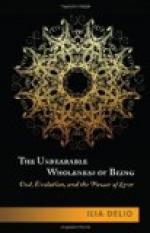Dissatisfaction with the life of the clergy and the tyranny of Rome was the more external reason which, although it vexed even those who were indifferent to religion, did not question the sacred tradition; the other reason was more a matter of principle; it was rooted in the desire for a religious revival and openly attacked perverted truths. The dreaded, hated, and cruelly persecuted heretics were fearless men, sturdily fighting for their convictions. The fundamental ideal of these reformers was the suppression of the outward pomp of the Church and the return to the simplicity of the gospels. Their fates varied. The gentle St. Francis of Assisi was canonised; the illumined Eckhart, on the other hand, was tortured; most of them, like the ardent Arnold of Brescia, were burnt at the stake. This conduct of the hierarchy towards the truly religious men is easily explained. The Church was faced by a problem; on the one hand, the genuine and profound piety of these men was unmistakable, but on the other, the contrast of their teaching with Church tradition was too obvious, and by many of them too strongly emphasised to be silently ignored.
The Provencal heretic, Peter of Bruis, seems to have been the first reformer who preached against iconolatry and even objected to the images of the Crucified. He ordered churches to be razed to the ground because he acknowledged only the invisible community of the saints. He was burnt at St. Giles’ by an infuriated mob. More powerful, and far more numerous than his followers, the Peterbrusians, were the Cathari and the Waldenses (founded by Peter Valdez A.D. 1177) who soon spread to Northern Italy and amalgamated with the sect of the Lombards. The Cathari advocated a simple and ascetic life, in accordance with the teaching of primitive Christianity, refrained from all ecclesiastical ceremonies and despised the sacraments, particularly baptism. More radical than later reformers, they rejected the doctrine of transubstantiation, and saw in the eucharist only a symbol of the union of God and the soul. This made their name synonymous with heresy. But by far the most famous of heretical sects was the sect of the Waldenses or Albigenses. It numbered amongst its adherents—if not publicly, at any rate secretly—many of the great Provencal lords, and there can be no doubt that this community was permeated by the spirit of a renewed Christianity, the Christianity of St. Francis and the German mystics. The Albigenses believed that not Christ, but His semblance only, had been crucified; they rejected the God of the Old Testament and their doctrine of the two creators,—the devil who created the objective world, and the true God who created the spiritual world—is reminiscent of the loftiest Parseeism and the profoundest gnosticism. They regarded man as placed between good and evil; the choice lay in his own hand. An extraordinary poem by Peire Cardinal—not by any means a heretic—breathes this spirit. He




